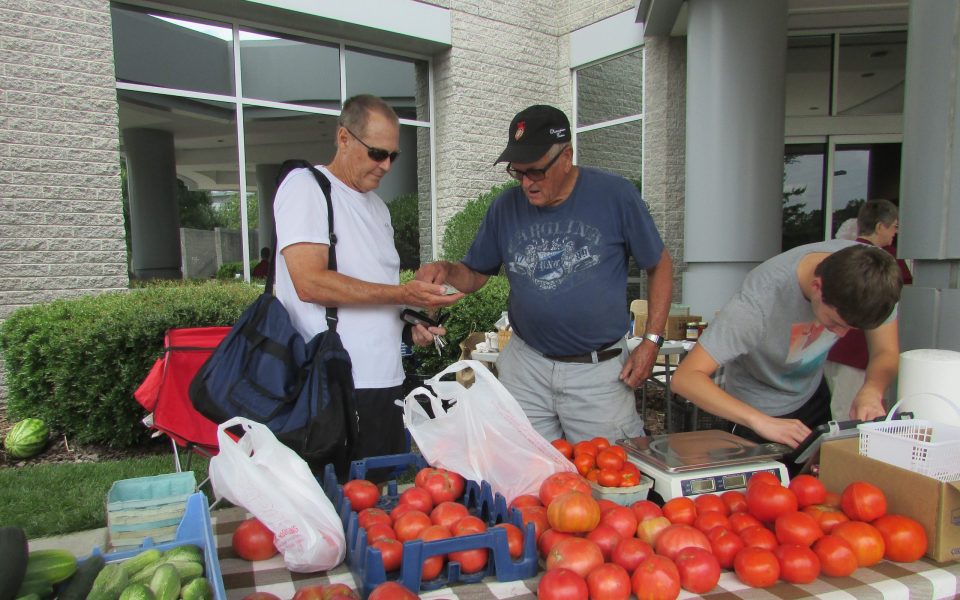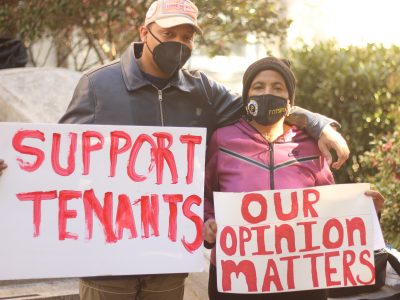by Jordan Green
An effort to market miniature “farm stands” around High Point is but one example in an array of grassroots efforts to address hunger.
Every Thursday, Lee Gann and Bobby Alcon set out their produce on tables flanking the entrance of the Fitness Center at High Point Regional Hospital. Their customers — nurses, hospital volunteers, patients and visitors on their way in to get their workouts —trickle past, peeling off dollar bills for peaches and tomatoes, baby potatoes and zucchini until the farmers pack away their produce and fold up their tables at 3 p.m.
Alcon, who is 82, farms what he calls “a large garden” in Wallburg, in Davidson County. He’s been selling his produce at the hospital every Thursday and in the parking lot in front of High Point Public Library every Saturday for seven or eight years, he said.
“It’s more or less a hobby and something to do,” Alcon said. “It’s profitable. It pays for itself and a little left over.”
Lately, Dustin Alcon, Bobby’s 16-year-old grandson, has been coming along and helping out.
“There’s a hot spot on that one,” Bobby told Dustin, handing the blemished fruit to his grandson so he could take it off the table.
Lee Gann, who also farms in Wallburg and on a piece of land owned by his uncle in Colfax, hasn’t been working the markets as long as Bobby Alcon, but has taken on a more extensive itinerary. Gann started selling produce at the hospital and library four years ago. Working with philanthropist Patrick Harman, he launched an occasional market at Washington Street Park three years ago. And two years ago, again working with Harman, Gann added five public-housing communities in High Point to his circuit.
Altogether, business has been “pretty decent,” Gann said, although resurfacing and utility work this summer has kept people away from the market at Washington Street Park.
“Since we started going into the housing authority communities, we’re able to bring in fresh produce,” he said. “They don’t have to drive 20 minutes to get to a store. A lot of them don’t have transportation. I’m trying to make a living, but I also try to offer a service.”
Between the public-housing communities and the hospital, along with the library, customers’ income covers a broad spectrum. Regardless, Gann said he tries to make his produce affordable to everyone. He’s able to accept EBT and SNAP benefits through a cell phone with an electronic swipe strip — an arrangement he worked out with technical assistance from the Guilford County Health and Human Services Department.
While efforts to address hunger have been ongoing in the city, which is currently ranked No. 1 for food hardship as part of the Greensboro-High Point metro area, the drive has picked up new momentum with the coalescence of the Greater High Point Food Alliance last October.
“One of the things we’re working on is getting the word out,” Executive Director Carl Vierling said. “People just don’t know where the resources are.”
Vierling said the idea of printing glossy cards publicizing nine different small-scale “farm stands” at different locations around the city at various times of the week came from an unidentified patron of the city’s HiTran bus system. A $900 grant from the Hayden-Harman Foundation covered the cost of designing and printing 5,000 cards, which are being distributed on the buses. The cards were only printed in late June, so Vierling said it’s too early to gauge how effective the marketing has been to connect people who lack food access with fresh produce.
Complementing the collaborative effort to provide fresh produce through farm stands, Vierling said the Mobile Oasis Farmers Market, a project of the Guilford County Health and Human Services Department, be coming to High Point.
Marianne LeGreco, who is involved with the effort, said the Mobile Oasis Farmers Market will be at Morehead Recreation Center on the second and fourth Mondays of each month, beginning on July 27, and at the High Point office of Guilford County Department of Social Services on the first and third Mondays, beginning on Aug. 3.
Vierling noted the link between public transportation and food insecurity.
“We found when we were doing surveys of our food partners — and this is definitely unscientific — 46 percent of people surveyed did not have their own transportation,” he said. “They were relying on others for transportation, walking or riding a bike.”
The farm stand at Washington Street Park is part of a larger health and wellness initiative funded by the Hayden-Harman Foundation, whose executive director is Patrick Harman.
Harman and Jakki Corvin, who runs a nonprofit called D-Up, started organizing a monthly summer program for neighborhood children three years ago. Through funding from the Hayden-Harman Foundation, the children receive $2 each to spend on produce from Lee Gann’s farm stand — an exercise that teaches them about food choices and handling money. About 30 children are enrolled in the summer program, Harman said.
Harman pointed out that the marketing campaign for the city’s farm stands is only one of many initiatives developing in High Point to attack food hardship. As an example, West End Ministries is working out a lease agreement with the city to start a community garden on a vacant lot.
The Greater High Point Food Alliance is holding a press conference on Wednesday (July 22) at United Way of Greater High Point, to highlight 90-day goals that have either been accomplished or significantly addressed, while making plans for its next phase.
“We’ve got some early wins,” Harman said. “The farm stands fit right in. There are so many strands. It all fits together, so it’s really cool. There are some pre-existing relationships, and new relationships that are being built.”
Join the First Amendment Society, a membership that goes directly to funding TCB‘s newsroom.
We believe that reporting can save the world.
The TCB First Amendment Society recognizes the vital role of a free, unfettered press with a bundling of local experiences designed to build community, and unique engagements with our newsroom that will help you understand, and shape, local journalism’s critical role in uplifting the people in our cities.
All revenue goes directly into the newsroom as reporters’ salaries and freelance commissions.





Leave a Reply